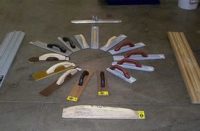The first day of the first annual Concrete Decor Show & Decorative Concrete Spring Training, held in March in Phoenix, came to a close with an early-evening talk by Mike Miller, founder of The Concretist, a decorative concrete artisans’ collective.
Miller, who is also a regular columnist in Concrete Decor magazine, was joined onstage by two of his colleagues: concrete and fabric artist Emily McClintick and real estate consultant Steve Crocker.
“We are an industry that attracts a lot of new people to it,” Miller said. “A lot of people here in this room came to learn and see people learning. That’s something we have in our favor.”
Miller spent the bulk of his talk discussing his approach to decorative concrete. He called his work “sensory concrete,” which he distinguished from “decorative concrete,” which involves incorporating decorative flourishes such as images of leaves, fish or grapes, and “architectural concrete,” which involves using disciplined approaches to add color and patterns within set boundaries. It’s this latter type of concrete that tends to invite raised expectations and court disappointment, he said.
“What I try to embrace is variegation and lack of control more than anything else,” he said.
Miller showed slides of some of his most creative projects, many of which he has described in columns for Concrete Decor, including work at a winery and several natural-food stores.
“I revel in the choreographed steps and serendipitous missteps of the placement process,” he said.
He also revealed a few of his colleagues’ favorite tricks of the trade, describing how a colorant-filled balloon disperses color like a little atom bomb when dropped onto a nail and exploding just above a surface.
“Most people in this business are artists — they’re just not quite ready to say that,” he said. “You need to think of yourself as an artist.”











